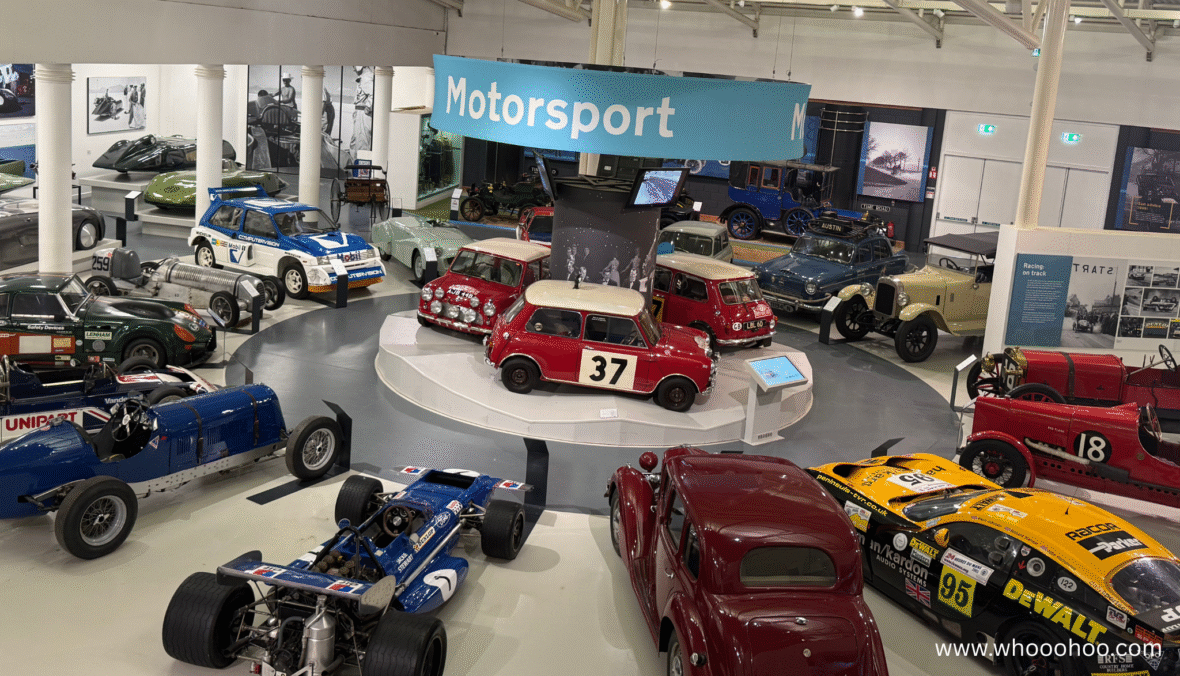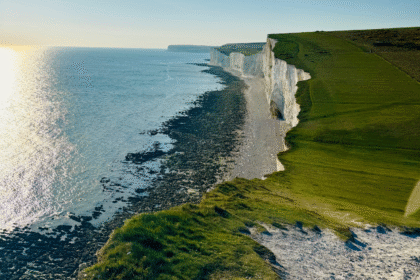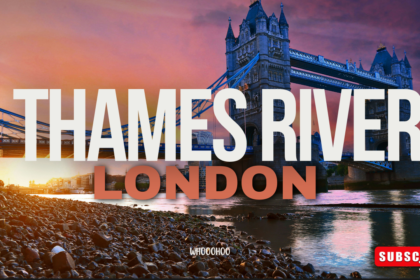British Motor Museum: The World’s Largest Collection of Historic British Cars
Explore the world’s largest collection of historic British cars, over 400 classic cars, celebrating the past, present, and future of British motoring. Enjoy free tours, happy family time, and create memories. Moreover, if you are a car enthusiast, then this place will be an ideal place to get insight into the British Motor industry.
The British Motor Museum is situated in the small village of Gaydon, Warwickshire, off junction 12 of the M40.
The Collections Centre building is a contemporary contrast to the Museum building, a magnificent example of art deco architecture. They stand proudly together in a 65-acre, beautifully landscaped setting that overlooks the Warwickshire countryside.
You can explore collections of more than 400 vintage British automobiles from the Jaguar Heritage Trust and the British Motor Industry Heritage Trust.
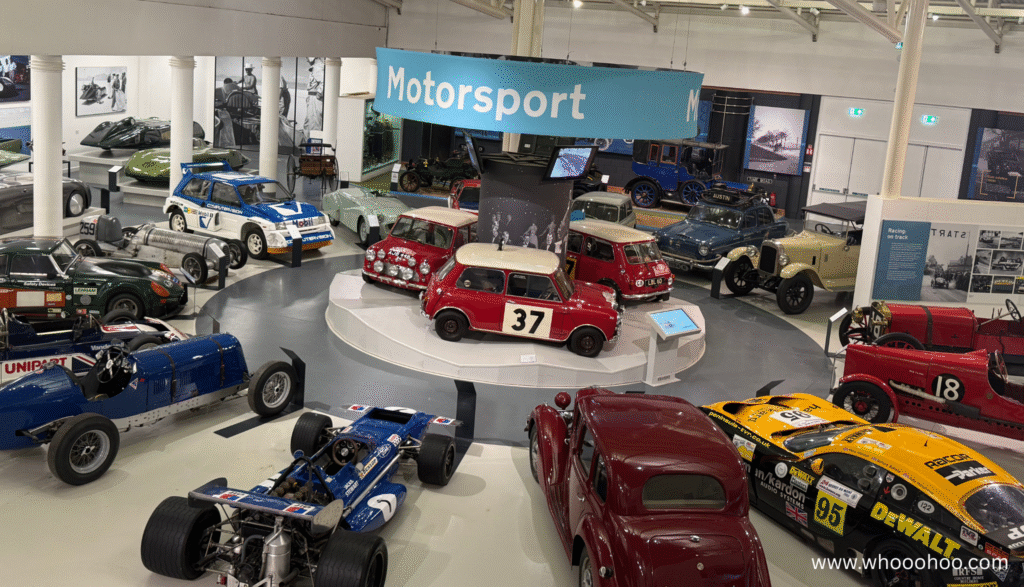
British Motor Museum
Walk down the ‘Time Road’ and see how family life and motoring have evolved over the years as the automobiles are brought to life by free guided tours and costumed explainers.
Explore “Making British Cars” to learn about the evolution of the automotive industry across time. Get “Under the Skin” and use interactive exhibits to solve the puzzle of how cars operate.
As part of the BL Heritage, the collection began with automobiles from British Leyland’s early years. In addition to well-known older brands like Austin and Morris, it has expanded throughout time to include vehicles from niche names like Land Rover and Jaguar, as well as smaller manufacturers like Morgan.
Discover who created the automobiles, where they were built, and interesting anecdotes from our knowledgeable guides. Take advantage of complimentary guided tours and entertaining, interactive family activities that make automobile history come to life, ideal for guests of all ages.
Witness the “behind the scenes” of how we maintain and store our cars in our Collections Centre, which houses more than 250 vehicles from the Jaguar Heritage Trust’s collection as well as our reserve car collection. From here, you can also see our antique automobile workshop’s ongoing repair efforts.
See how automobiles and daily life have evolved from the 1900s to the present by taking a stroll down the “Time Road.” Discover how the UK automobile industry has influenced the world over time by exploring the “Making British Cars” exhibit.
Highlights of the British Motor Museum
- Discover 300 vintage British vehicles and the people who built them, as well as the locations where they were built.
- With period music, take a stroll along the “Time Road” to learn about the changes in automobiles, motoring, and family life over the years.
- Learn about the impact of the automotive industry and its promising future in “Making British Cars.”
- Are you aware of the distinction between power steering and rack and pin? Learn about the operation of automobiles through interactive displays.
- Additionally, there is free parking, an outdoor play area, and a café on site that serves hot and cold meals and snacks.
- Wheelchairs and mobility scooters can easily reach our accessible venue.
How long does it take to go round the British Motor Museum?
You need 3 to 4 hours to explore the British Motor Museum, including the Collections Centre. You might wish to stay at the museum for even longer if you intend to attend family-friendly events or enjoy a guided tour.
What are the ticket prices for the British Motor Museum?
Guide Prices of the British Motor Museum
|
Ticket Type |
Ticket Tariff |
|
Advanced adult ticket |
£17 Per Ticket |
|
Advanced child ticket (age 5 – 16) |
£9 Per Ticket |
|
Advanced concession ticket |
£15 Per Ticket |
|
Advanced family of 4 Advanced family of 5 |
£46 Per Ticket £52 Per Ticket |
|
On the day adult ticket |
£20 Per Ticket |
|
On the day child ticket (5 – 16) |
£10 Per Ticket |
|
On the day concession ticket |
£18 Per Ticket |
|
On the day family of 4 ticket On the day family of 5 ticket |
£52 Per Ticket £58 Per Ticket |
Do you need to book in advance to visit the British Museum?
No, reservations are not required to visit the British Museum, however, they are strongly advised. Although walk-up access to the museum’s permanent collection is free, purchasing a free timed-entry ticket online guarantees that you will receive important information and updates before your visit and grants you priority entry at busy times.
Which is the biggest motor museum in the UK?
The largest automobile museum in the United Kingdom is the British Automobile Museum, located in Gaydon, Warwickshire. More than 400 vintage British automobiles are kept there, including well-known types like the original Mini and Land Rover. Over a million archival artefacts about the British automobile industry are also on display at the museum.
Other well-known automotive museums in the UK are the National Automotive Museum in Beaulieu, Hampshire, which has a collection of more than 280 vehicles, and the Haynes Motor Museum in Somerset, which displays more than 300 automobiles and motorcycles. But the British Motor Museum has the largest collection.
Famous Cars You Can See at the British Motor Museum
A huge number of well-known British automobiles at the British Motor Museum includes iconic models, rally champions, and prototypes. The Morris Mini Cooper S, which won the Monte Carlo Rally in 1965, the 1968 Triumph Lynx prototype, and the 1971 Rolls-Royce Silver Shadow are a few noteworthy examples. Among the other unusual designs in the museum is the 1955 Rover Gas Turbine Base Unit.
1961 Ford Zodiac Mk II
The Zodiac made its début in 1954 under the name Zephyr Zodiac. In 1956, the Zodiac Mk II came after it. These models, together with the Consul Mk II, were referred to as “The Three Graces.” Beginning in 1972, the Consul Granada series gradually replaced this entire line.
The Zodiac Mk II maintained many of the same design features as its predecessor, including the two-tone colour scheme, whitewall tires, and gold-plated trunk insignia, but added other style cues to make it stand out. Its gaudy, American-inspired appearance was quickly rendered obsolete by the change in automotive fashions in the 1960s. These features included a broad front grille, wraparound back windows, and prominent tail fins.
In 1962, production came to an end, and the Zodiac Mk III, which had even more noticeable tail fins, replaced it. There were two design variations for the Zodiac and Zephyr: the Mk I “Highline” and the Mk II “Lowline.”
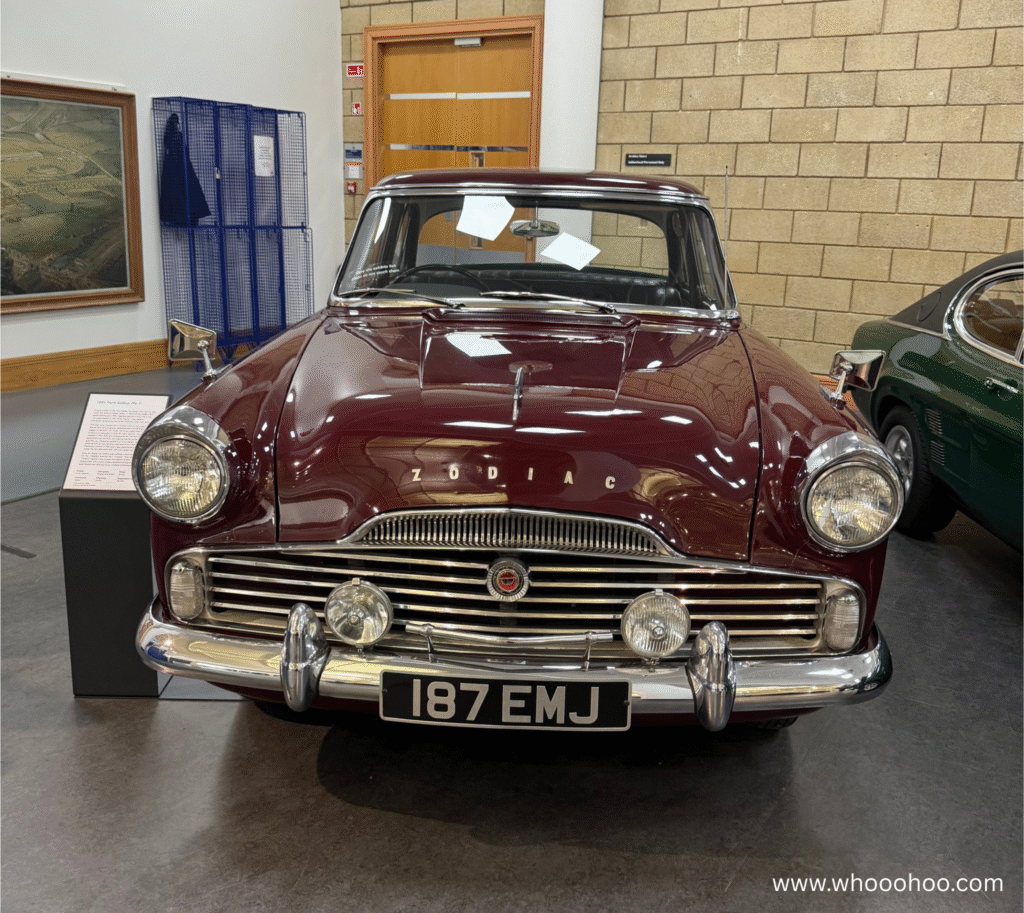
1961 Ford Zodiac Mk II
Engine: 6 cyl. 2553 cc
Top speed: 85 mph (137 km/h]
Power: 85 bhp
Coachwork: saloon
Price new: £1.012
Registration mark: 187 EMJ
Accession number: L20242
On loan from the Ford Motor Company
Ferguson Formula 4×4
After going into production in 1968, the Ford Capri debuted in public at the 1969 Brussels Motor Show. It was marketed as “the car you’ve always promised yourself,” and it sold 400,000 copies in its first two years of release. Before the end of Mk III manufacture in 1986, the Capri saw three significant iterations.

1973 Ford Capri Mk I
With motorsport purposes in mind, Ford’s Competition Department created a four-wheel-drive Capri variant. Two Capri prototypes were transferred to Harry Ferguson Research (HFR), a business he founded to create four-wheel-drive systems appropriate for mass-market automobiles, before the Capri’s official 1969 introduction. In 1960, his son-in-law, Tony Sheldon, succeeded Ferguson as CEO of the company.
The Capri 4×4 sparked similar developments by other companies, while never going into mass production. Coventry-based FF (Ferguson Formula) Developments Limited modified a German-imported Capri in 1973. The upgrade included a modified Broadspeed engine, an automated gearbox, and anti-lock braking. The modification cost £1,637.94, which at the time was almost the same as the price of a regular Capri.
Engine: V6 cyl, 2994 cc
Top speed: 120 mph [193 km/h
Registration mark: VHJ 493L
Price new: £1,831 unmodified
Accession number: L20243
On loan from Mark Wheatley
1986 Ford RS200
Group B rally car
In 1982, the Group B set of rallying rules was developed by the Fédération Internationale du Sport Automobile. Numerous automakers, including Austin Rover, Peugeot, Lancia, Audi, and Ford, felt compelled to be part of the Group as a result of the restrictions, which promoted extremely fast, powerful, and highly advanced vehicles.
Ford specifically created the RS200 to be a Group B rally car. It was lightweight, featured a mid-mounted turbocharged engine, four-wheel drive, and a fibreglass coupé shell. To meet the homologation standards, Ford had Reliant of Tamworth build 200 units, which were completed in 1986. While rally-spec versions of the RS200 produced 350 to 450 horsepower, the base model only produced 250 horsepower. It slowed and flared exhaust flames.
However, following several fatal crashes involving the class, FISA banned Group B vehicles in 1987. Ford made significant investments in the RS200 before converting the vehicles into high-end sports variants with interiors designed by coachbuilder Tickford. One such vehicle was never utilised in competition despite being constructed by Ford apprentices to exacting rally specifications.
Engine: 4 cyl, 1804 cc
Top speed: not quoted
Power: not quoted
Coachwork: coupé
Accession number: L2024.9
On loan from the Ford Motor Company
Price new: not quoted
Registration mark: none
1971 Rolls-Royce Silver Shadow
The Silver Shadow is still the most-produced Rolls-Royce model to date and was the first model to have a unitary (monocoque) body and chassis structure. The Silver Shadow, created by John Polwhele Blatchley, was a major improvement over the Silver Cloud. Despite being shorter and thinner, it offered more room for people and their belongings.
Its hydropneumatic self-leveling suspension, licensed from Citroën, and dual-circuit braking system, which were technologically advanced for their day, helped to provide the renownedly smooth ride that made it “the best car in the world.” A GM 400 automatic transmission was mated to a 6.75-liter L-series V8 engine under the hood that generated about 190 horsepower.
The original model, subsequently dubbed the Silver Shadow I, is the one on exhibit. When Rolls-Royce produced the Silver Shadow II in 1976, it came with major upgrades like better suspension and rack-and-pinion steering, which greatly enhanced the car’s handling.
Engine: V8 cyl, 6759 cc
Top speed: 120 mph [193 km/h]
Coachwork: saloon
Price new:£9,925
Power: 190 bhp
Registration mark: FMW 353J
Accession number: 2022-41-1
Free Entry to the British Motor Museum with a Blue Peter Badge
Did you know that the British Motor Museum offers free admission to those who have earned the Blue Peter badge? We take pride in being one of more than 200 attractions in the UK that offer free admission to Blue Peter badge holders.
To be eligible for free admission:
- A valid Blue Peter badge and Blue Peter badge ID card must be shown by each child.
- A full-paying or concessionary adult must accompany children.
- Both youngsters are admitted free of charge if a paying adult is accompanied by two qualifying badge holders.
As long as accompanying documentation is shown, visitors with disabilities who possess a Blue Peter badge, along with their registered carer, are also eligible for free admission. Please be aware that on up to five special show days annually, Blue Peter badges and other promotional offers are not valid.
For the most recent information and dates of special events, see the British Motor Museum’s website before you go. A parent or guardian should go over the Blue Peter Badge Attractions Terms and Conditions with you.
Do you want a badge? To take advantage of this wonderful offer, learn how to apply for a Blue Peter badge and remember to bring your badge ID card!
Opening Times
Dates: 2 Jan 2025 – 23 Dec 2025
|
Day |
Times |
|
Monday |
10:00 – 17:00 |
|
Tuesday |
10:00- 17:00 |
|
Wednesday |
10:00- 17:00 |
|
Thursday |
10:00- 17:00 |
|
Friday |
10:00 – 17:00 |
|
Saturday |
10:00 – 17:00 |
|
Sunday |
10:00- 17:00 |
